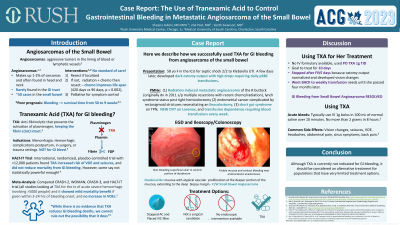Sunday Poster Session
Category: Small Intestine
P1277 - Case Report: The Use of Tranexamic Acid to Control Gastrointestinal Bleeding in Metastatic Angiosarcoma of the Small Bowel
Sunday, October 22, 2023
3:30 PM - 7:00 PM PT
Location: Exhibit Hall

Has Audio
- SG
Sheena Gillani, MD, MPH
Rush University Medical Center
Chicago, Illinois
Presenting Author(s)
Sheena Gillani, MD, MPH, Zoë Post, MD, Garth Swanson, MD, MS
Rush University Medical Center, Chicago, IL
Introduction: Angiosarcomas are an aggressive and uncommon form of malignant neoplasm that develop in the lining of blood and lymphatic vessels. They rarely present in the gastrointestinal (GI) tract, with GI bleeding a common symptom yet poor prognostic indicator that shortens the median survival time from 50 to 9 weeks. Although surgical resection is often recommended, most patients are poor surgical candidates; therefore, finding alternate treatments is imperative to improving survival. Recent studies have found improved survival rates when tranexamic acid, an antifibrinolytic agent, is used to treat general GI bleeding. However, few have described the use of tranexamic acid for GI bleeding from angiosarcoma of the small bowel.
Case Description/Methods: Our patient is a 58-year-old female that was admitted to the ICU for septic shock secondary to complicated Klebsiella UTI; however, a few days after admission, she developed persistent dark ostomy output and associated decreases in hemoglobin. Her past medical history includes lynch syndrome status post right hemicolectomy, endometrial cancer complicated by rectosigmoid strictures necessitating an ileocolostomy, short gut syndrome on TPN, history of DVT on Lovenox, radiation induced metastatic angiosarcoma of the lower extremities currently on chemotherapy, and transfusion dependence requiring blood transfusions every week. However, this admission she was requiring blood transfusions daily, even after anticoagulation was discontinued. An EGD showed multiple mucosal nodules, diffusely friable mucosa, and multiple superficial non-bleeding ulcers in the duodenum. An ileoscopy was also performed due to continued bleeding, which showed diffusely mildly congested, erythematous, and friable tissue of the small bowel (Figure 1). No targetable lesion was identified for intervention during either procedure, but biopsies of the duodenum showed atypical vascular proliferation, which oncology suspected was angiosarcoma of the small bowel. Since no endoscopic or surgical intervention was indicated, patient was started on 1 gram of tranexamic acid every 8 hours for a total of 10 days. However, medication was stopped on day 5 due to resolution of GI bleed and development of blurry vision. Several weeks have passed since receiving tranexamic acid and the patient has not required any red blood cell transfusions.
Discussion: Overall, the use of tranexamic acid should be further studied as an alternative treatment for GI bleeding due to small bowel angiosarcoma. received
Disclosures:
Sheena Gillani, MD, MPH, Zoë Post, MD, Garth Swanson, MD, MS. P1277 - Case Report: The Use of Tranexamic Acid to Control Gastrointestinal Bleeding in Metastatic Angiosarcoma of the Small Bowel, ACG 2023 Annual Scientific Meeting Abstracts. Vancouver, BC, Canada: American College of Gastroenterology.
Rush University Medical Center, Chicago, IL
Introduction: Angiosarcomas are an aggressive and uncommon form of malignant neoplasm that develop in the lining of blood and lymphatic vessels. They rarely present in the gastrointestinal (GI) tract, with GI bleeding a common symptom yet poor prognostic indicator that shortens the median survival time from 50 to 9 weeks. Although surgical resection is often recommended, most patients are poor surgical candidates; therefore, finding alternate treatments is imperative to improving survival. Recent studies have found improved survival rates when tranexamic acid, an antifibrinolytic agent, is used to treat general GI bleeding. However, few have described the use of tranexamic acid for GI bleeding from angiosarcoma of the small bowel.
Case Description/Methods: Our patient is a 58-year-old female that was admitted to the ICU for septic shock secondary to complicated Klebsiella UTI; however, a few days after admission, she developed persistent dark ostomy output and associated decreases in hemoglobin. Her past medical history includes lynch syndrome status post right hemicolectomy, endometrial cancer complicated by rectosigmoid strictures necessitating an ileocolostomy, short gut syndrome on TPN, history of DVT on Lovenox, radiation induced metastatic angiosarcoma of the lower extremities currently on chemotherapy, and transfusion dependence requiring blood transfusions every week. However, this admission she was requiring blood transfusions daily, even after anticoagulation was discontinued. An EGD showed multiple mucosal nodules, diffusely friable mucosa, and multiple superficial non-bleeding ulcers in the duodenum. An ileoscopy was also performed due to continued bleeding, which showed diffusely mildly congested, erythematous, and friable tissue of the small bowel (Figure 1). No targetable lesion was identified for intervention during either procedure, but biopsies of the duodenum showed atypical vascular proliferation, which oncology suspected was angiosarcoma of the small bowel. Since no endoscopic or surgical intervention was indicated, patient was started on 1 gram of tranexamic acid every 8 hours for a total of 10 days. However, medication was stopped on day 5 due to resolution of GI bleed and development of blurry vision. Several weeks have passed since receiving tranexamic acid and the patient has not required any red blood cell transfusions.
Discussion: Overall, the use of tranexamic acid should be further studied as an alternative treatment for GI bleeding due to small bowel angiosarcoma. received
Disclosures:
Sheena Gillani indicated no relevant financial relationships.
Zoë Post indicated no relevant financial relationships.
Garth Swanson indicated no relevant financial relationships.
Sheena Gillani, MD, MPH, Zoë Post, MD, Garth Swanson, MD, MS. P1277 - Case Report: The Use of Tranexamic Acid to Control Gastrointestinal Bleeding in Metastatic Angiosarcoma of the Small Bowel, ACG 2023 Annual Scientific Meeting Abstracts. Vancouver, BC, Canada: American College of Gastroenterology.

